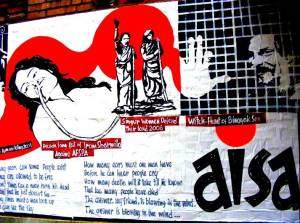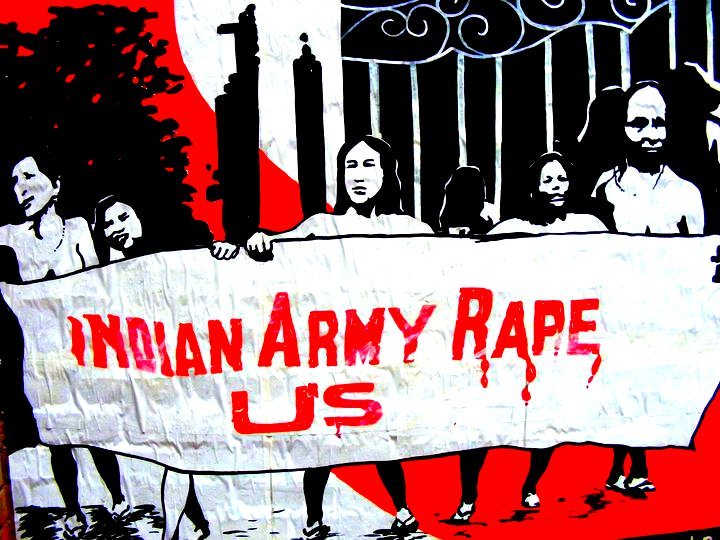Sometimes you find yourself incapacitated; you struggle, vapid restlessness takes over your being and you are forced to acknowledge that at times, one can never find the right word to explain the existence of certain moments. This precisely sums up my reaction when I first heard of the Thangjam Manorama case which shook the instilled illusions of safety, that I naïvely possessed and further exposed the denigrated status of women in India.
It was in the night of July 10, 2004: Manorama was picked up from her home by the Indian paramilitary unit, 17th Assam Rifles- her cries were stifled, no explanations were sought and she was ruthlessly dragged off for questioning. Insinuations about Manorama were abound around this time- she was allegedly linked through various ideological capacities to the People’s Liberation Army (PLA) (although Manorama and her family strongly refuted the same). That the PLA was (and is) an active insurgent group that based its identity on socialist separatism leading it to be designated as a terrorist organisation by Government of India, gave the unit necessary leeway for their actions . The next morning found Manorama’s discarded corpse, punctured with bullet wounds and slandered with indisputable lacerations (an autopsy revealed semen traces-clearly affirming rape).
Widespread public pressure was witnessed (on Manorama’s death, thirty odd women spearheaded the protests by marching naked holding a banner stating-‘Indian Army rape us too’). Inconsistencies marked the subsequent trials that took place- although an independent enquiry commission was set up, culpability could not be assigned.
If ‘why’ followed by a gargantuan question mark is what you want to vocalize, you are not on the wrong trail of questioning. Armed Forces Special Powers Act 1958, more popularly known by the mnemonic AFSPA is the reason behind the treatment meted out.
The AFSPA is a law which through the means of just six sections grants special powers to the Indian Armed Forces for actions undertaken in what the act terms as ‘disturbed areas’. Plainly put, it legalises any perpetration by the armed forces functioning in the areas of Assam and Manipur (Jammu and Kashmir has its own version which was promulgated too). Explicit immunity is thus assured, leading to the gross violation of human rights and the likes.
Although the grounds for execution of the AFSPA were challenged in the Supreme Court on the grounds that it violates and quite virtually abrogates various rights (such as: to life, to equal protection under law and to equality before the law), the plea was unsuccessful. The tenet of impunity (assured through the AFSPA) has succeeded in creating a shroud of invisibility- attacks on vulnerable citizens increased in profusion after the enactment of the AFSPA (the act transgresses various international statutes such ICCPR, CEDAW et al). The same view was reiterated by the Human Rights Watch, quoting—‘The act is tool of state abuse, oppression and discrimination’.

Wall art at JNU, New Delhi
In fact, even though the Justice J.S. Verma Committee purported the reviewing and immediate dilution of the act, non-acquiescence and abject inaction was the response received. The committee had made some very pertinent suggestions- including setting a mandatory time frame for detaining of women (in conflict areas), witness protection, bringing attacks instigated against such women under the normal CrPC etc. It is pathetic to note that, none of the above expressed have even been considered- the army continues to express the need of the act to combat militancy operations (no, never mind the reductions in insurgency statistics). Thus, India while wrapping itself under the garb of democracy, is contradicting the constitutionally granted rights and responsibilities.
Intentional infliction of pain with the aim of weaning information or a confession by any person acting so due to official capacity.
Torture is defined along these lines by the United Nations Torture Convention of 1984. If so, Manorma and countless others without discriminating across genders, have been tortured with the AFSPA being wielded as the excuse. Ten whole years after the incident, Manorama’s family recorded a victory in 2014, the Supreme Court ordered the center to release a sum of Rupees Ten lakhs as compensation – implicitly according responsibility.
But one has to note, this is a small consolation.
Very recently, on April 6th, 2015, an Army troop molested three women (including a minor) in Karbi Anglon, Assam. Again, the jawans are being protected under the shield created very conveniently by the AFSPA and thus right to redressal is being denied, yet again.
Silence, silence and more silence- this has become a way of life for the Indian woman. Yes, there have been various struggles, protests, dharnas conducted over the years- all unequivocally advocating the repelling of the assuredly archaic act. For instance, Irom Chanu Sharmila (classified rightly as a ‘prisoner of conscience’) is one such strong advocate- whose existence assures the non seepage of any lag into the momentum of the movement. But, one has to note that the movement (against AFSPA) is limited to only certain pockets of India. This has to change; it is time pan-Indian agitations were recorded.
Indian women have been stifled enough- their entrapment was (and still is) in complicit with the male hegemony. It is time the women rise and traverse over the constant constrictions in ply. We have to let the resilience that is inherent of the fabric of our skin, to come to the fore. Rise, woman and vociferously speak up-if not you, then who?
Featured Image Credit: Wall art at JNU, New Delhi
About the author(s)
Passionate Feminist. Straight ally. Doodler. Believes purpose of one's life should be larger than self. Social Work Student.




